What Is The Structure Of A Animal Cell
Definition of animal cell
An fauna jail cell is a eukaryotic prison cell that lacks a cell wall, and information technology is enclosed by the plasma membrane. The cell organelles are enclosed past the plasma membrane including the cell nucleus. Unlike the animate being cell lacking the cell wall, plant cells have a jail cell wall.
- Animals are a big group of diverse living organisms that make up three-quarters of all species on globe. With their ability to move, respond to stimuli, reply to environmental changes, and adapt to different modes of feeding defense force mechanisms and reproduction, all these mechanisms are enhanced by their constituent elements in the body. However, animals cannot manufacture their own food like plants and hence they depend on plants in one way or another.
- All living things are fabricated up of cells that make up their body structure. Some of these living things are single-celled (unicellular) and other organisms are fabricated upwardly of more than one cell (Multicellular).
- A cell is the smallest (microscopic) structural-functional unit of life of an organism. The cells that constitute an animal are chosen Animal cells and those that constitute plants are known as plant cells.
- Nearly cells are covered by a protective membrane known as the cell wall which gives the cells their shape and rigidity.
- Since animal cells lack a rigid cell wall it allows them to develop a peachy diversity of cell types, tissues, and organs. The nerves and muscles are made up of specialized cells that constitute cells cannot evolve to form, hence giving these nerve and muscle cells have the ability to move.
Animal cell size and shape
- Animal cells come in all kinds of shapes and sizes, with their size ranging from a few millimeters to micrometers. The largest brute jail cell is the ostrich egg which has a 5-inch diameter, weighing about ane.two-ane.four kg and the smallest animal cells are neurons of about 100 microns in bore.
- Beast cells are smaller than the plant cells and they are generally irregular in shape taking various forms of shapes, due to lack of the jail cell wall. Some cells are round, oval, flattened or rod-shaped, spherical, concave, rectangular. This is due to the lack of a cell wall. Note: virtually of the cells are microscopic hence they tin only be seen under a microscope in order to written report their beefcake.
- Simply animal cells share other cellular organelles with plant cells as both have evolved from eukaryotic cells.
- As noted earlier, animal cells are eukaryotic cells with a membrane-leap nucleus. therefore they have their genetic material in the form of DNA enclosed in the nucleus. They also accept several structural organelles within the plasma membrane which perform diverse specific functions for proper prison cell function and generally to maintain the body normal mechanisms.
List of Fauna cell organelles
- Plasma membrane (Jail cell membrane)
- Nucleus
- Cytoplasm
- Mitochondria
- Ribosomes
- Endoplasmic Reticulum (ER)
- Golgi apparatus (Golgi bodies/Golgi complex)
- Lysosomes
- Cytoskeleton
- Microtubules
- Centrioles
- Peroxisomes
- Cilia and Flagella
- Endosome
- Vacuoles
- Microvilli
Brute cell construction
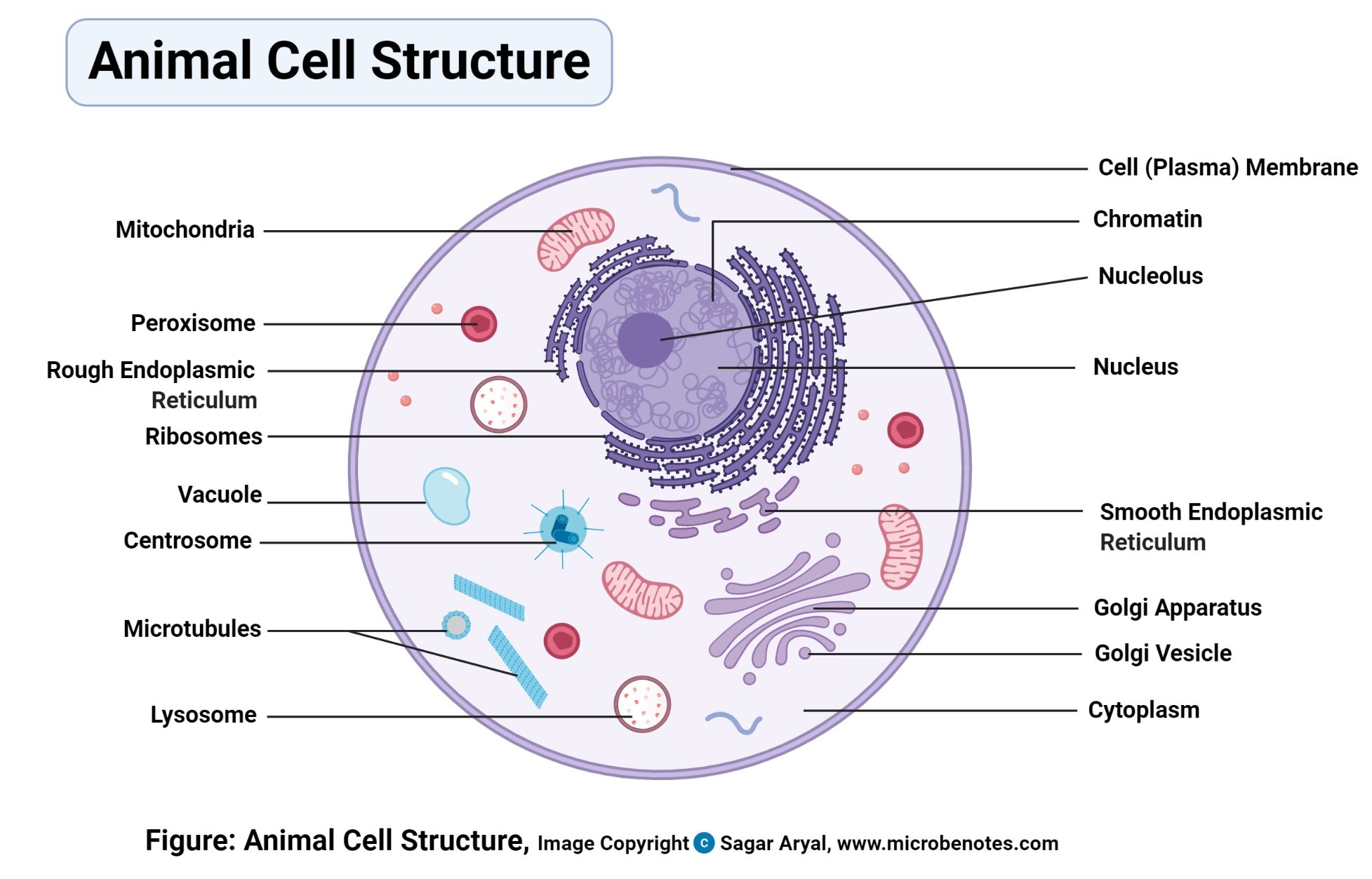
Effigy: Diagram of Animal Cell, created with biorender.com
The animal cell is fabricated upwards of several structural organelles enclosed in the plasma membrane, that enable it to function properly, eliciting mechanisms that benefit the host (animal). The working together of all cells gives an fauna its ability to motility, to reproduce, to respond to stimuli, to digest and absorb food, etc. Generally, the combined effort past all beast cells is what enables the normal operation of the torso.
Animate being Jail cell Free Worksheet
Answer central

Fauna cell organelles
The major prison cell organelles include:
Plasma membrane (Cell membrane)
Definition of Plasma membrane (Cell membrane)
Information technology is a thin semipermeable poly peptide-membrane layer that surrounds an animate being prison cell.
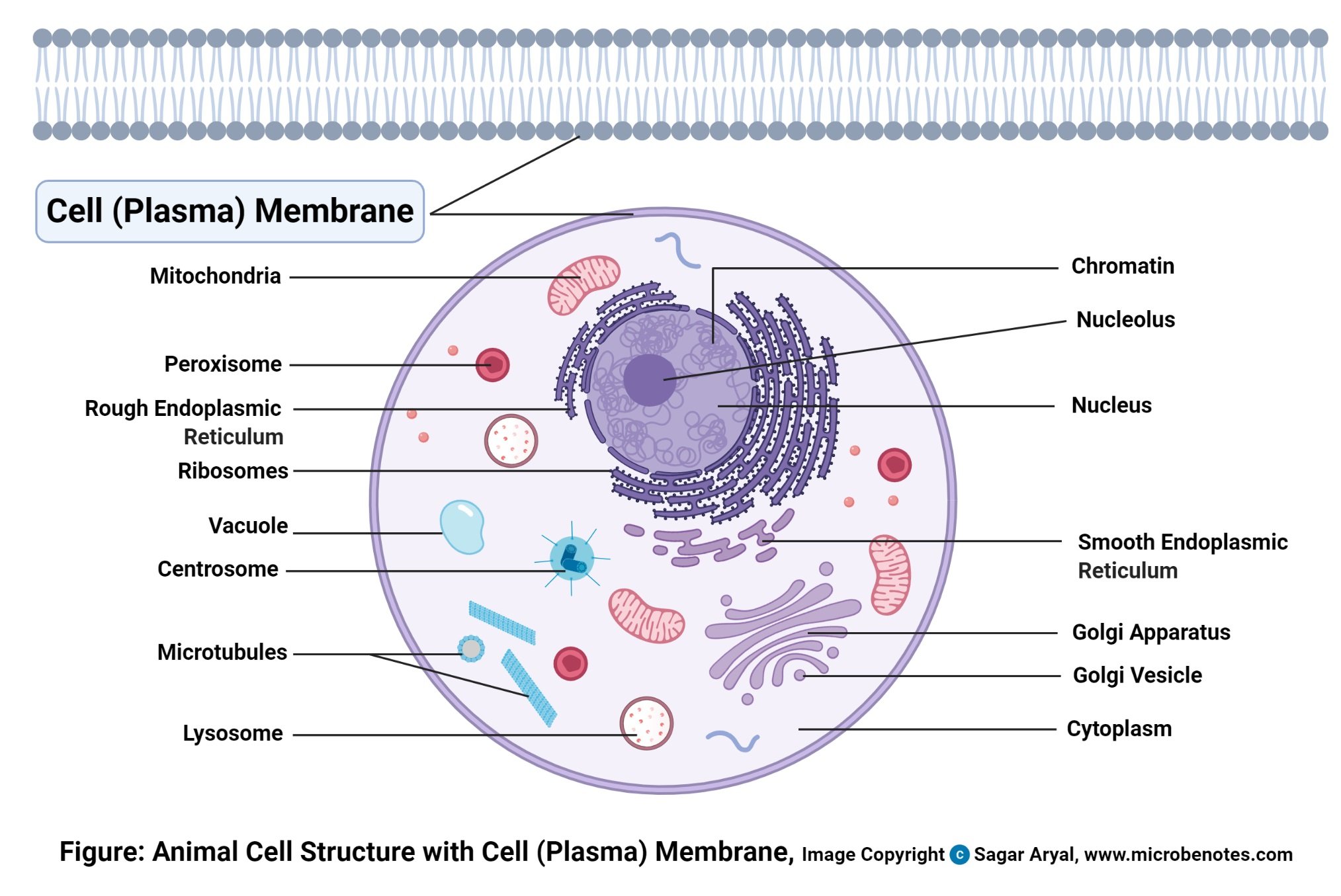
Figure: Diagram of Plasma membrane (Prison cell membrane), created with biorender.com
Structure of Plasma membrane (Cell membrane)
- Sparse semi-permeable membrane
- It contains a percentage of lipids making a semi-permeable bulwark between the cell and its concrete surroundings.
- It has some protein components a
- It is very consistent effectually the cell
- All living cells have a plasma membrane.
Functions of Plasma membrane (Cell membrane)
- To enclose and protect the jail cell content
- To too regulate the molecules that pass into and out of the cell, through the plasma membrane. Therefore it controls homeostasis.
- The proteins are actively involved in transporting materials across the membrane
- The proteins and lipids allow jail cell communication, and carbohydrates (sugars and saccharide chains), which decorate both the proteins and lipids and help cells recognize each other.
Nucleus
Definition of Nucleus
- This is a spherical structured organelle found majorly at the center of a cell surrounded by a double-layered nuclear membrane separating it from the cytoplasm.
- Information technology is held together to the cytoplasm with the help of the filaments and microtubules.
- It holds other cells organelles including the nucleolus, nucleosomes, and chromatins.
- A prison cell has one nucleus which divides producing multinucleated cells east.chiliad. the skeletal muscle jail cell fibers.
- Some cells lose their nuclei after maturations east.chiliad. the red blood cells.
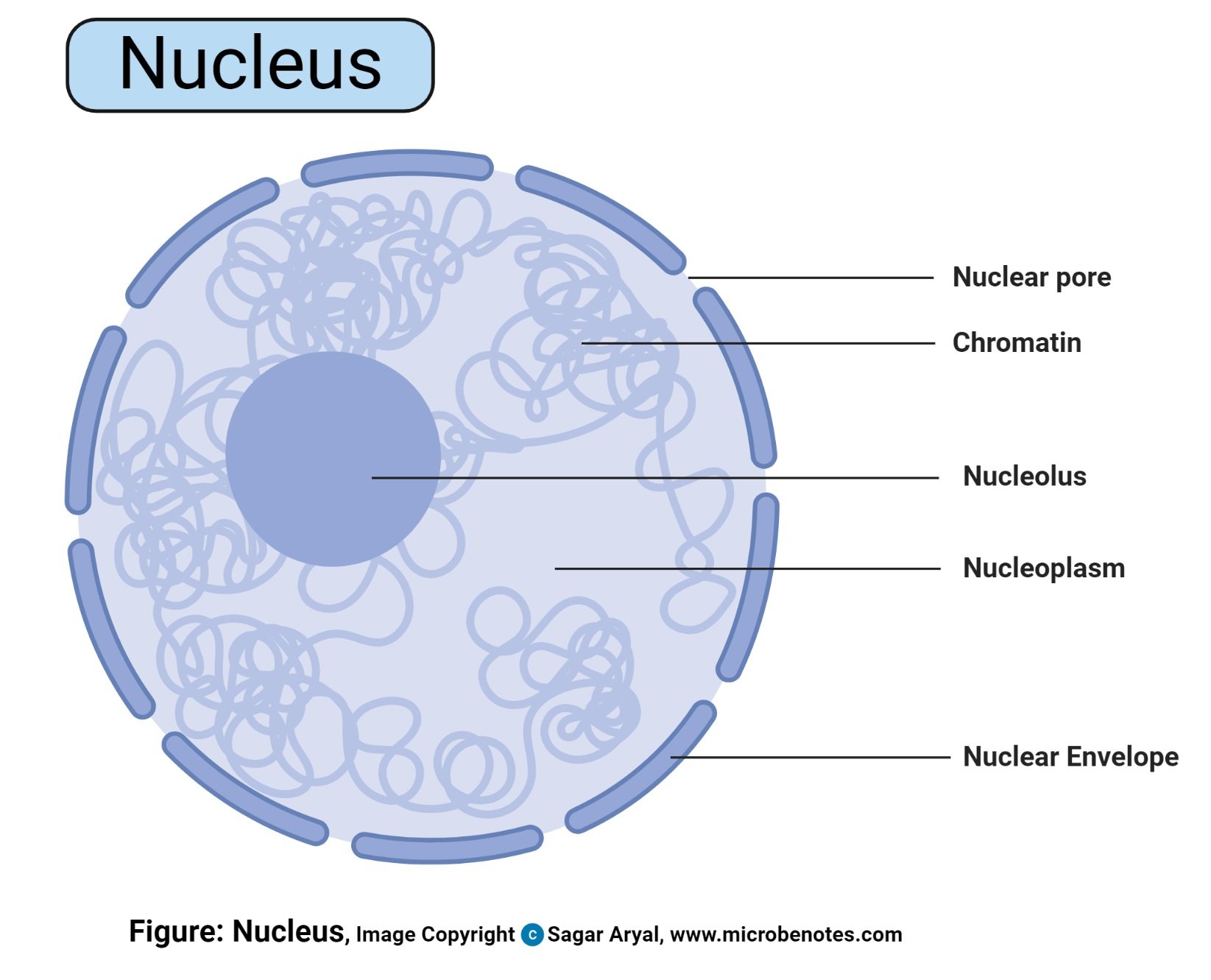
Effigy: Diagram of Nucleus, created with biorender.com
Structure of Nucleus
- The double-layered membrane is a continuous channel of bleary from the endoplasmic reticulum network.
- The membrane has pores which allow entry of large molecule
- Nucleoli (Singular; nucleolus) are tiny/small bodies institute in the nucleus
- The nucleus and its component organelles are suspended in the nucleoplasm (Business firm of the chromosomal DNA and genetic materials)
Functions of Nucleus
- The principal role of the nucleus is to control and regulate cell activities of growth and maintain cell metabolisms.
- It as well carries the genes that accept hereditary data of the cell.
- The chromosomal DNA and genetic materials, which are fabricated up of genetic coded ultimately brand up their proteins' amino acrid sequences for use by the cell.
- Therefore, the nucleus is the information center.
- It is the site for Transcription (formation of mRNA from Dna) and the mRNA is transported to the nuclear envelope.
Cytoplasm
Definition of Cytoplasm
- This is a gel-similar fabric that contains all the cell organelles, enclosed inside the cell membrane.
- These organelles include; Mitochondria, ribosomes, Endoplasmic reticulum, Golgi apparatus, lysosomes intermediate filaments, microfilaments microtubules, vesicles.

Figure: Diagram of Cytoplasm, created with biorender.com
Mitochondria
Definition of Mitochondria
- These are membrane-bound organelles located in the cytoplasm of all eukaryotic cells
- The number of mitochondria found in each cell varies widely depending on the office of the cell it performs.
- For instance, erythrocytes do not have mitochondria while the liver and muscle cells have thousands of mitochondria.
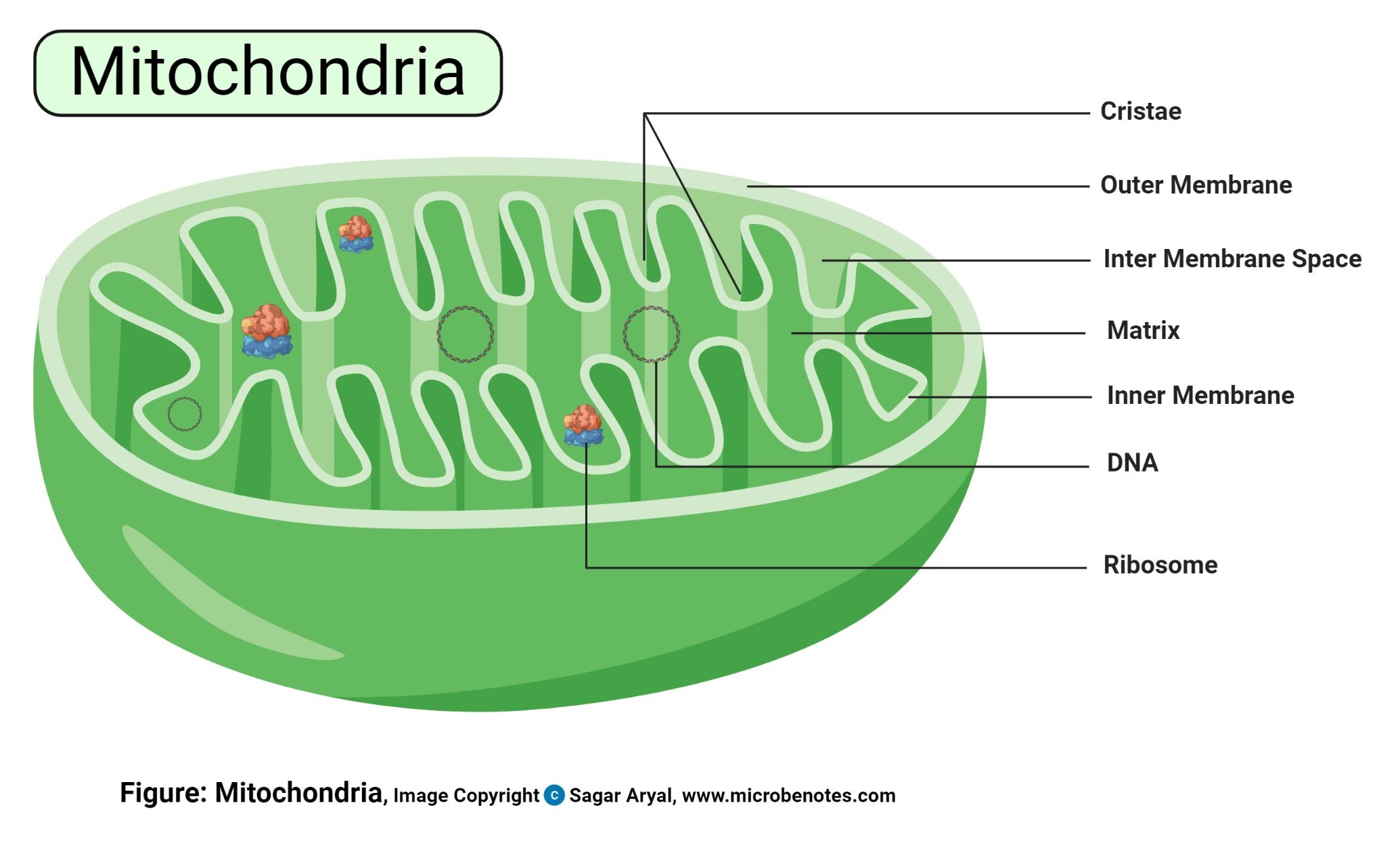
Effigy: Diagram of Mitochondria, created with biorender.com
Structure of Mitochondria
- They are rod-shaped or oval or spherically shaped, with a size of 0.5 to 10 μm.
- Mitochondria accept two special membranes – outer and inner membrane.
- They have a mitochondrial gel-matric in the primal mass.
- The membranes curve into folds known equally cristae.
Functions of Mitochondria
- Their master part is to generate free energy for the cell i.east they are the power generators, producing energy in grade of Adenosine Tri-phosphate (ATP), by converting nutrients and oxygen into energy enabling the jail cell to perform its function and to also release excess energy from the prison cell.
- Mitochondria also shop calcium which assists in prison cell signaling activity, generating cellular and mechanical estrus and mediating cellular growth and expiry.
- The outer membrane is permeable, allowing the send of small molecules and a special channel to send big molecules.
- The inner mitochondrial membrane is less permeable thus allowing very modest molecules into the mitochondrial gel-matrix in the cardinal mass. The gel matrix is composed of the mitochondria Dna and enzymes for the Tricarboxylic Acrid (TCA) cycle or the Kreb'due south Bicycle.
- The TCA cycle uses up the nutrients, converting them into by-products that the mitochondria use for producing energy. These processes take place in the inner membrane considering the membrane bends into folds called the cristae, where the poly peptide components used for the master free energy production system cells, known every bit the Electron Transport Chain (ETC). ETC is the main source of ATP production in the body.
- The ETC involves several sequences of oxidation-reduction reactions to transport electrons from one poly peptide component to some other, thus producing energy that is used for phosphorylation of ADP (Adenosine diphosphate) to ATP. This process is called the chemiosmotic coupling of oxidative phosphorylation. This machinery gives energy to most cellular activities including muscle movement and they power upwards the general brain function.
- Some if not all proteins and molecules that make up the mitochondria come from the cell nucleus. The mitochondrial nucleus genome has 37 genes of which 13 of these genes produce most of the components of the ETC. However, mitochondrial DNA is very vulnerable to mutations because they don't possess a large DNA repair mechanism, a common element found in other nuclear DNAs.
- Moreover, Reactive Oxygen Species ((ROS)) also chosen free radicals are produced in the mitochondrion, because of the preference for abnormal production of free electrons. These electrons are neutralized by antioxidant proteins in the mitochondrion. However, some of the costless radicals can impairment mitochondrial DNA (mtDNA).
- Equally, consumption of alcohol tin cause damage to the mtDNA because excess ethanol in the torso causes saturation of the detoxifying enzymes leading to the production and leakage of highly reactive electrons into the cytoplasmic membrane and into the mitochondrial matrix, combining with other cellular molecules forming numerous radicals that significantly cause cell impairment.
- Most organisms inherit the mtDNA from their mother. This is because the maternal egg donates almost of the cytoplasm to the embryo while the mitochondria inherited from the begetter's sperm is destroyed. This causes the origin of inherited and acquired mitochondrial diseases due to mutations transmitted into the embryo from the maternal and paternal Deoxyribonucleic acid or maternal mtDNA. Such diseases include Alzheimer's disease and Parkinson's disease. When mutated mtDNA accumulates over time has been linked to crumbling and the evolution of certain cancers and diseases.
- Naturally, mitochondria play a major role in programmed prison cell death (apoptosis) and due to mutations in the mtDNA can inhibit jail cell death-causing the development of cancer.
Ribosomes
Definition of Ribosomes
- They are small organelles majorly fabricated upwards of sixty% RNA cytoplasmic- granules and twoscore% proteins.
- All living cells contain ribosomes, which may be freely circulating in the cytoplasm and some are bound to the endoplasmic reticulum.
- Information technology is the site for protein synthesis.
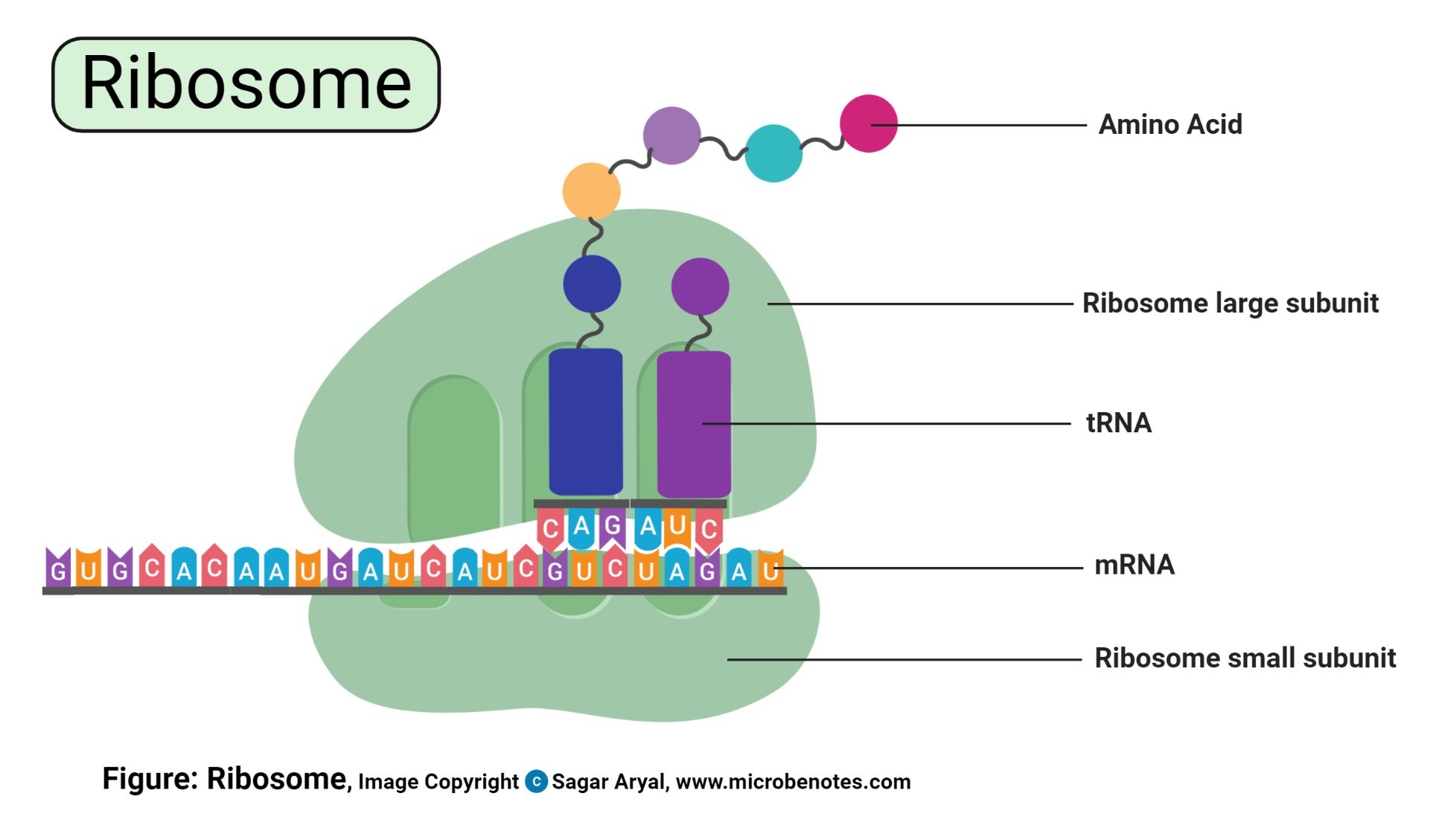
Effigy: Diagram of Ribosome, created with biorender.com
Construction of Ribosomes
- Ribosomes are fabricated up of ribosomal proteins and ribosomal RNA (rRNA). In a eukaryotic prison cell, ribosomes establish half ribosomal RNA and half ribosomal proteins.
- Each ribosome is made up of two subunits i. e large subunit and small subunit with their own singled-out shapes. These subunits are designated as the 40s and 60s in the creature jail cell.
Functions of Ribosomes
- Ribosomes that occur equally costless particles are attached to the endoplasmic reticulum membrane occurring in large numbers bookkeeping for about a quarter of the cell organelles. A unmarried replicated prison cell has about ten 1000000 ribosomes.
- The ribosomal subunits are the site for genetic coding into proteins. On the ribosomes, the mRNA helps determine the coding for Transfer RNA (tRNA) which also determines the protein amino acrid sequences. This leads to the formation of the rRNA which are involved in the catalyzation of peptidyl transferase creating the peptide bond found betwixt the amino acid sequences that develop the proteins. The formed proteins then detach from the ribosomes, migrating to other cell parts for utilization by the prison cell.
Endoplasmic Reticulum (ER)
Structure of Endoplasmic Reticulum (ER)
- This is a continuous folded membranous organelle institute in the cytoplasm fabricated up of a sparse network of flattened interconnected compartments (sacs) that connects from the cytoplasm to the cell nucleus.
- Within its membranes, at that place are membranous spaces chosen the cristae spaces and the membrane folding are called cristae.
- At that place are 2 types of ER based on their structure and the role they perform including Rough Endoplasmic reticulum and the Smooth endoplasmic reticulum.
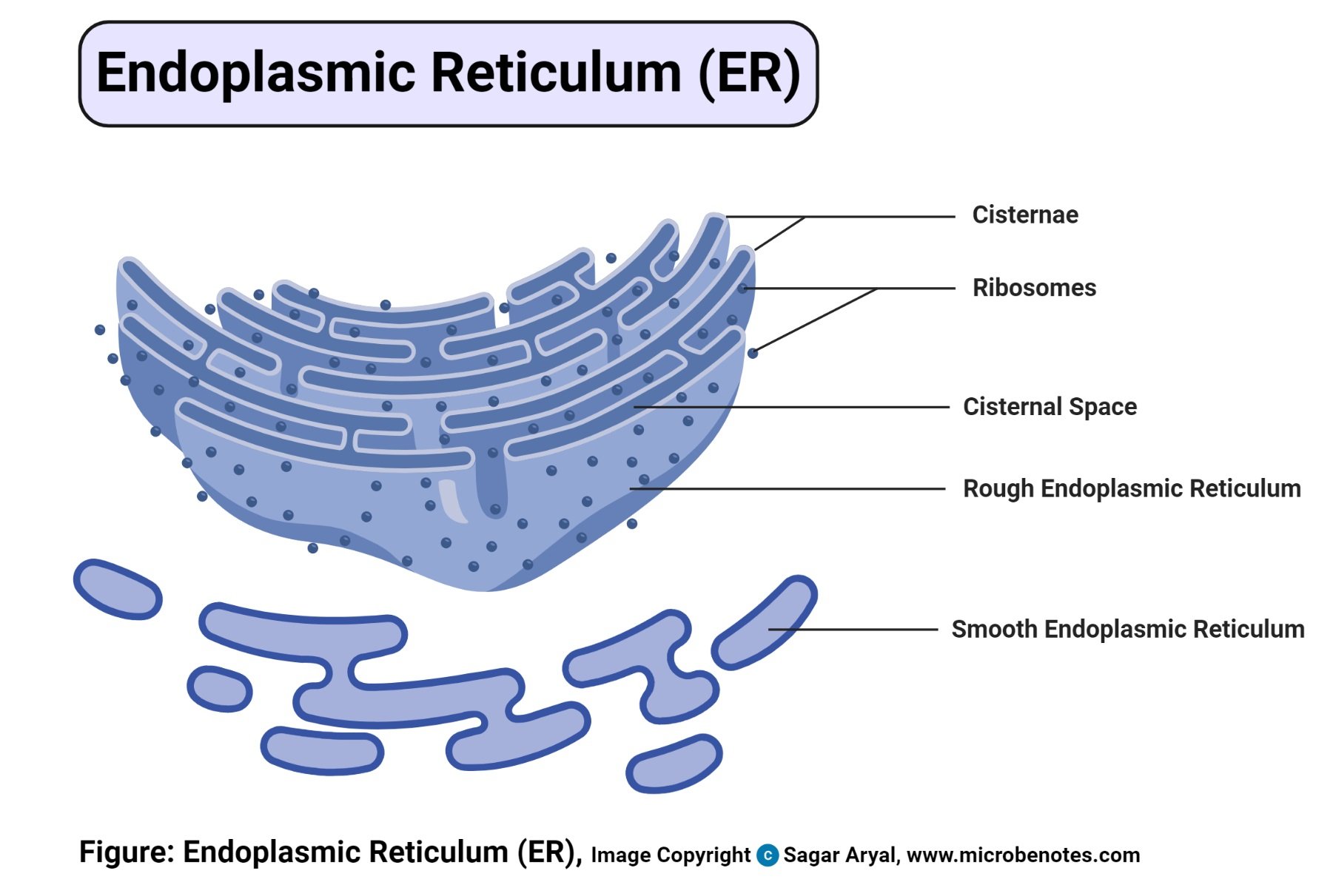
Effigy: Diagram of Endoplasmic Reticulum (ER), created with biorender.com
Functions of Endoplasmic Reticulum (ER)
- Manufacturing, processing and transporting proteins for jail cell utilization both in and out of the cell. This is considering it is direct connected to the nuclear membrane providing a passage between the nucleus and the cytoplasm.
- The ER has more than than half the bleary cell content, hence it has a large surface expanse where chemic reactions take place. They likewise contain the enzymes for almost all the cell lipid synthesis hence they are the site for lipid synthesis.
The variation in physical and functional characteristics differentiate the ER into two types i.east Rough endoplasmic reticulum and Smoothen endoplasmic reticulum.
Types of Endoplasmic Reticulum
- Rough Endoplasmic Reticulum (Rough ER) – Rough ER is called "rough" considering there surface is covered with ribosomes, giving it a rough appearance. The function of the ribosomes on rough ER is to synthesis proteins and they have a signaling sequence, directing them to the endoplasmic reticulum for processing. Crude ER transports the proteins and lipids through the cell into the cristae. They are so sent into the Golgi bodies or inserted into the cell membrane.
- Polish Endoplasmic Reticulum (Smooth ER) – Smooth ER is not associated with ribosomes and their unction is different from that of the rough endoplasmic reticulum, despite lying next to the crude endoplasmic reticulum. Its function is to synthesis lipids (cholesterol and phospholipids) that are utilized for producing new cellular membranes. They are also involved in the synthesis of steroid hormones from cholesterol for certain cell types. It also contributes to the detoxification of the liver later on the intake of drugs and toxic chemicals.
- In that location is likewise a specialized type of smooth ER known as the sarcoplasmic reticulum. Its function is to regulate the concentration of Calcium ions in the musculus cell cytoplasm.
Golgi apparatus (Golgi bodies/ Golgi complex)
Construction of Golgi apparatus (Golgi bodies)
- These are membrane-spring cell organelles institute in the cytoplasm of a eukaryotic cell, next to the endoplasmic reticulum and near the nucleus.
- Golgi bodies are supported together by cytoplasmic microtubules and held by a poly peptide matrix
- It is made upwards of flattened stacked pouches known as cisternae.
- These cisternae may be 4- x in number for creature cell Golgi bodies though some organisms like unmarried-celled organisms have about 60 cisternae.
- They have three master compartments known as cis (Cisternae Nearest the Endoplasmic Reticulum), medial (central layers of cisternae) and the trans (cisternae uttermost from the endoplasmic reticulum).
- Beast cells have very few (one-2) Golgi bodies while plants have a few hundred.
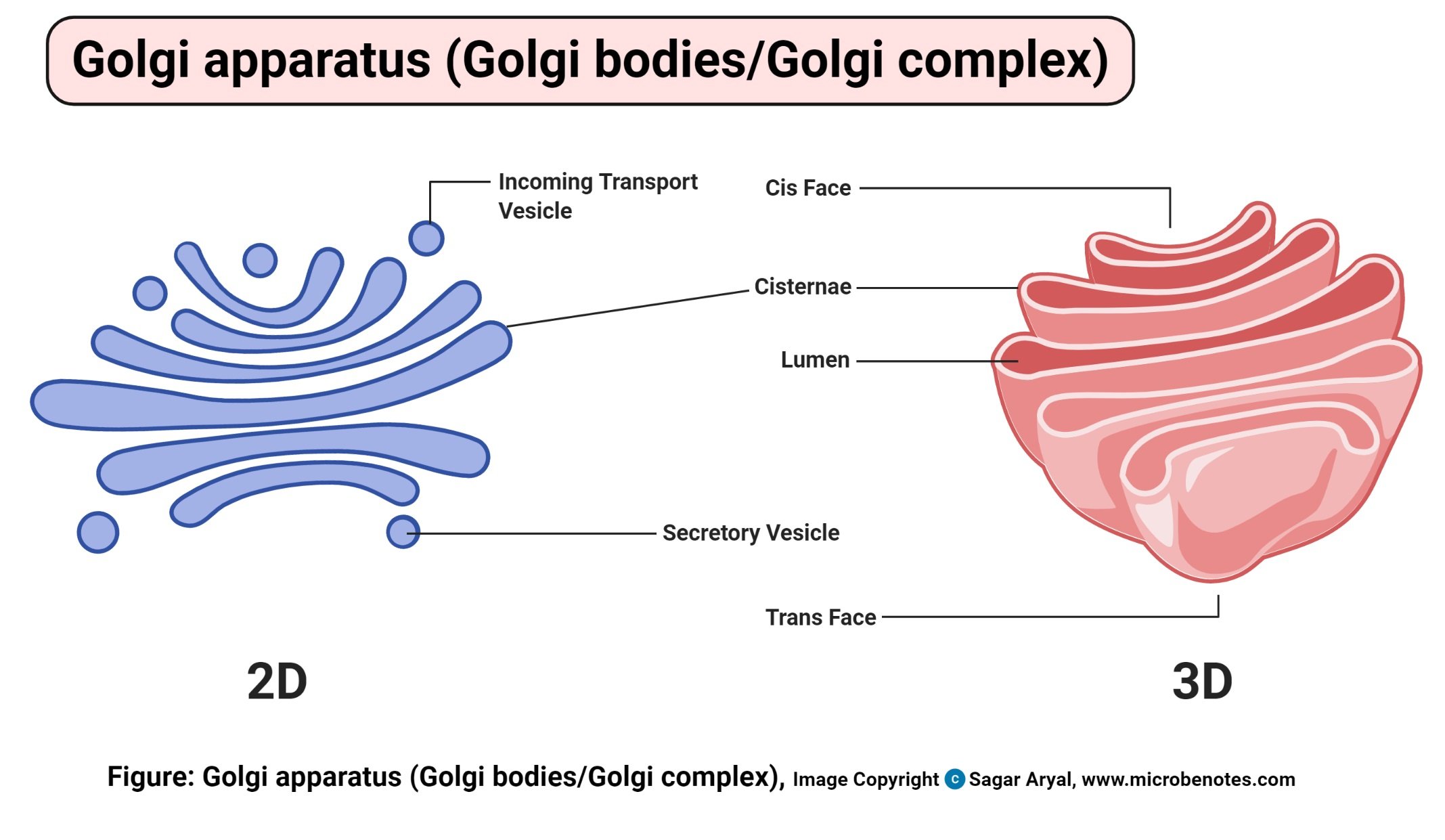
Effigy: second and 3D Diagram of Golgi apparatus (Golgi bodies or Golgi complex), created with biorender.com
Functions of Golgi apparatus (Golgi bodies)
- Their primary office is to ship, change and pack proteins and lipids into the Golgi vesicles to deliver them to their target sites. Brute cells contain one or more Golgi bodies while plants have a few hundred.
- Cis and trans Golgi network make upward the outer layer of cisternae at the cis and trans face up and they are responsible for sorting proteins and lipids received at the cis face and released by the trans face, past the Golgi bodies.
- The cis face collects the proteins and lipids, of fused vesicles in clusters. The fused vesicles move along the microtubules through a specialized compartment known as the vesicular-tubular cluster. This compartment is found between the endoplasmic reticulum and the Golgi apparatus.
- The vesicle clusters fuse with the cis Golgi network, delivering the proteins and lipids into the cis confront cisternae and as they move from the cis face to the trans face up, they get modified to functional units. These functional units go delivered to intracellular and extracellular components of the cell.
- Modification mechanisms include:
- Cleaving of oligosaccharides chains
- Zipper of sugar moieties of different side bondage
- Adding fatty acids and/or phosphate groups by phosphorylation, and/or removing monosaccharides e.1000. the removal of the mannose moieties takes identify in the cis and the medial cisternae while adding of galactose takes place in the trans cisternae.
- Sorting of the modified proteins and lipids occurs in the trans-Golgi network and packed into the trans vesicles, which then delivers them to the lysosomes or sometimes to the cell membrane for exocytosis. Assisted by ligands leap to receptors triggering fusion and poly peptide secretion.
Lysosomes
It is as well known as cell vesicles; Lysosomes were discovered by Christian Rene de Duve, a Belgian cytologist in the 1950s.
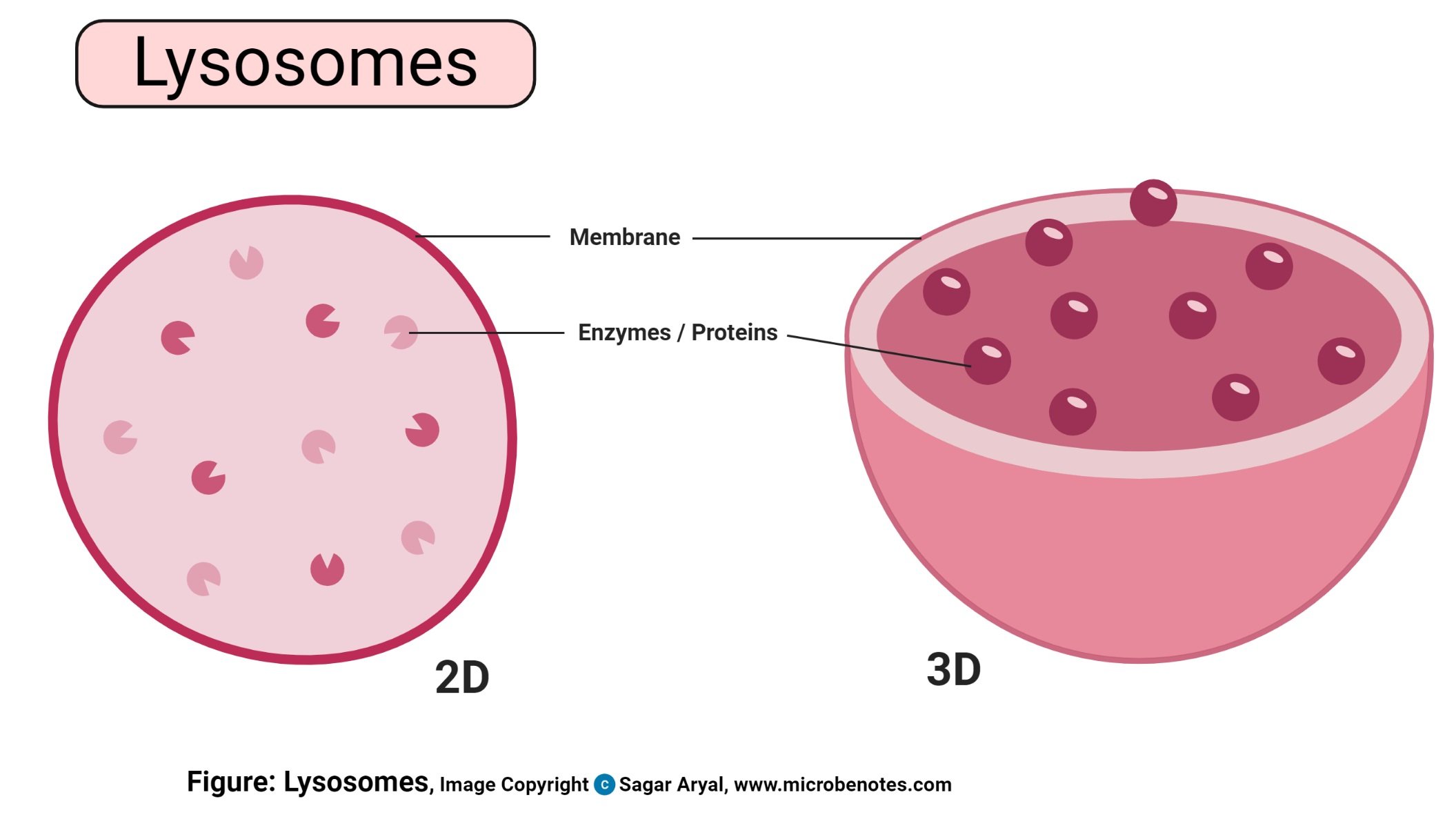
Figure: 2nd and 3D Diagram of Lysosomes, created with biorender.com
Structure of Lysosomes
- They are round subcellular organelle institute in almost all eukaryotic cells
- Lysosomes are very acidic organelles containing the digestive enzymes and therefore each of the lysosomes is surrounded by a membrane to protect it from the outer environs.
Functions of Lysosomes
- This is the site for digestion of jail cell nutrients, excretion, and cell renewal.
- Lysosomes break down macromolecules components from the exterior of the cell into simpler elements that are transported into the cytoplasm via a proton pump to build new cell materials.
- These macromolecule components include old cells and parts, cell waste products, microorganisms, and cell debris.
- The digestive enzymes found in the lysosomes are called hydrolytic enzymes or acrid hydrolases, breaking down big molecules into smaller molecules that can be utilized by the jail cell.
- These enzymes also intermission down big molecules e. g proteins, carbohydrates, lipids, into small molecules e.g. amino acids and simple sugars, fatty acids, respectively.
- Note: The enzymes are agile merely on the inside of the acidic lysosome and their acidity protects the cell from degrading itself when in that location is lysosomal leakage because the cell pH is neutral to slightly alkali metal.
Cytoskeleton
Construction of Cytoskeleton
- This is a fibrous network that's formed from and past different proteins of long chains of amino acids.
- These proteins are plant in the prison cell cytoplasm of the eukaryotic cells.
- They are also made up of iii types of tiny filaments: Actin filaments (Microfilaments), Microtubules, Intermediate filaments.
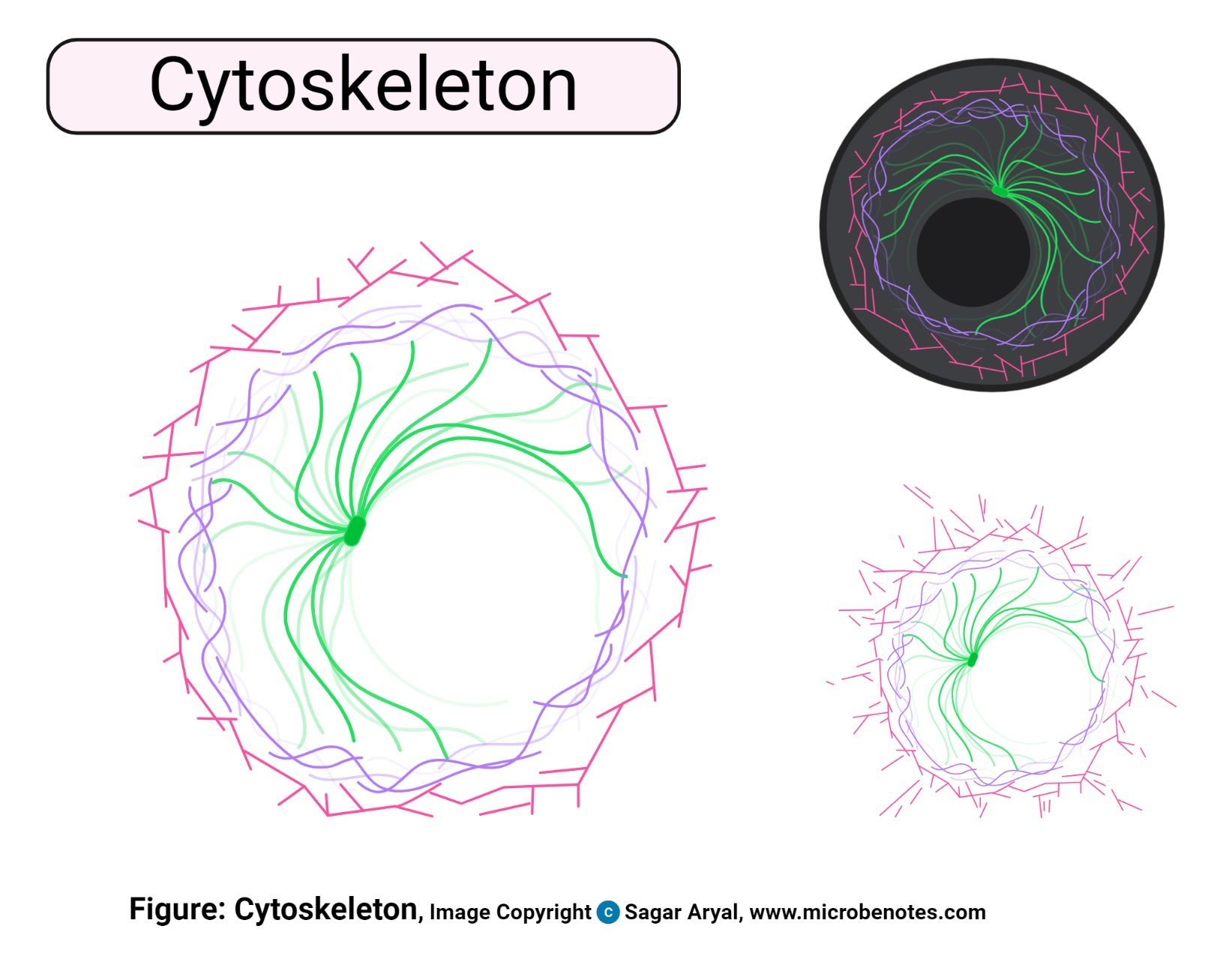
Figure: Diagram of Cytoskeleton, created with biorender.com
Functions of Cytoskeleton
- The cytoskeleton functions to create a network organizing the jail cell components and to also maintain the cell shape.
- It also provided a compatible movement of the prison cell and its organelles, by the filament system network establish in the cell'due south cytoplasm.
- It also organizes some of the cell components maintaining the prison cell shape
- It plays a major part in the movement of the jail cell and some cell organelles in the cytoplasm.
- The tiny filaments include:
- Actin filaments; likewise known equally microfilaments; it's a meshwork of fibers running parallel to each other and they play a master role in giving the prison cell its shape; they alter consistently, helping the cell to move and to as well mediate certain cell activities such as adherence ability to substrates and cleavage mechanisms during mitotic cell division
- Microtubules-these are long filaments that assist in mitosis moving daughter chromosomes to new forming daughter cells.
- Intermediate filaments– they are more stable filaments in comparison to the actin and microtubules. They course the true skeleton of the cell, and the hold the nucleus in its rightful position within the cell.
- It too allows the prison cell'due south elasticity factor enabling it to endure concrete tension.
- Other proteins that may be added every bit role of the cytoskeleton of the cell include septin ((assembles the filaments) and spectrin (help maintain the structure of the cell by pulling together the cell membrane with the intracellular surface of the cell).
Microtubules
Structure of Microtubules
- These are long, straight, hollow cylinders filaments that are constructed from 13-15 sub-filaments (protofilament) strand of a special globular protein chosen tubulin, plant only in eukaryotic cells.
- They are found throughout the cytoplasm of the fauna jail cell.
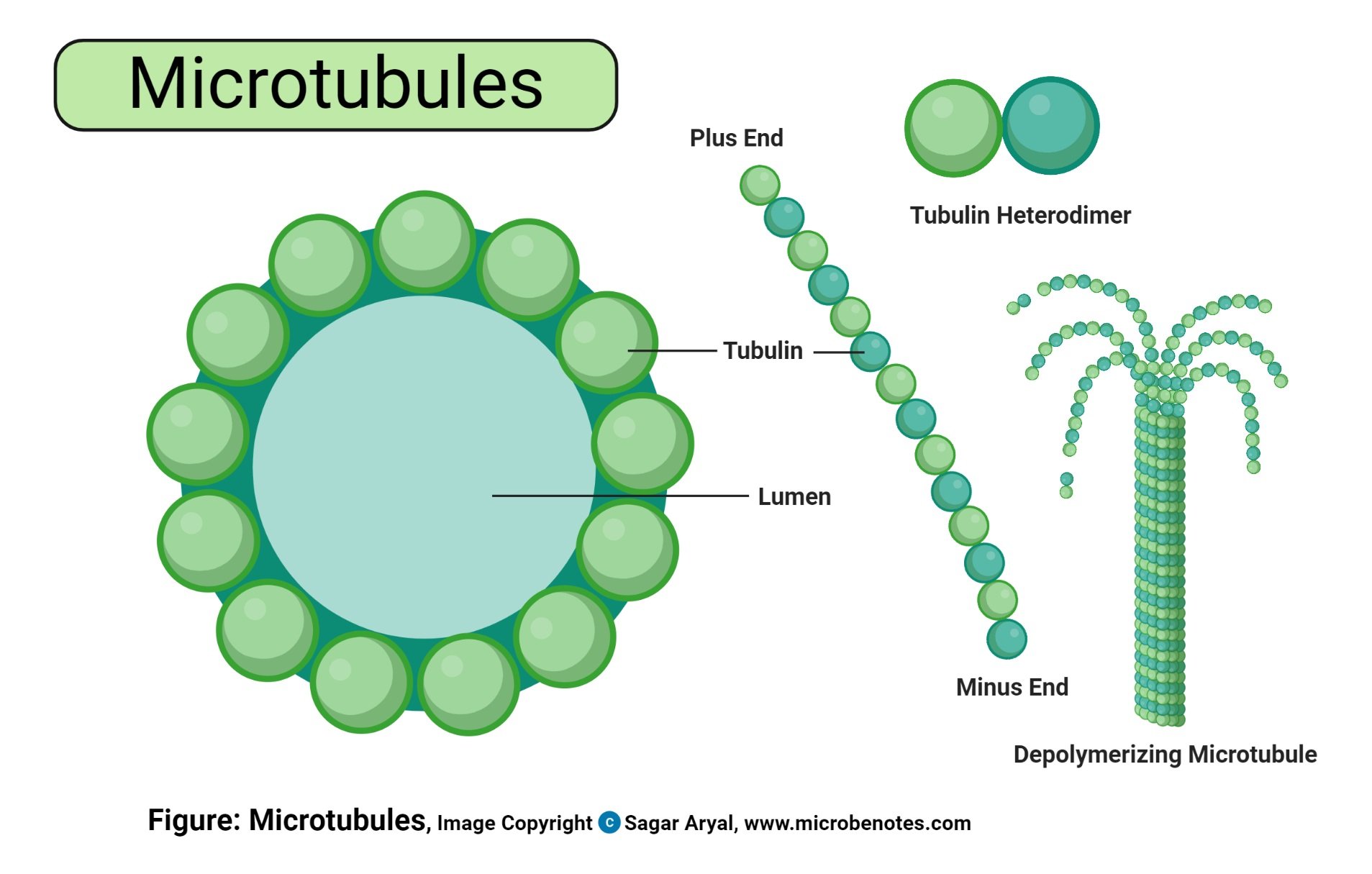
Figure: Diagram of Microtubules, created with biorender.com
Functions of Microtubules
- Transportation of some organelles like the mitochondria and the vesicles i.e. transporting vesicles from the neuron cell trunk to the axon tips, and back to the prison cell torso
- Structural support, they give characteristic support to the Golgi bodies, holding them within the gel-matrix of the cytoplasm.
- They provide the rigid and organized component of the cytoskeleton of the cell, enabling a jail cell to take up a item shape.
- They are the chief elements that brand up the locomotive projections of a jail cell (cilia and flagella)
- They also play a role in forming the spindle fibers of the chromosome of the cell during mitotic cell division.
Centrioles
This is distinctly plant in the animate being prison cell, which has the ability to replicate or brand copies by itself. It is fabricated up of ix microtubule bundles and their primary office is to assist in organizing the prison cell sectionalisation process.
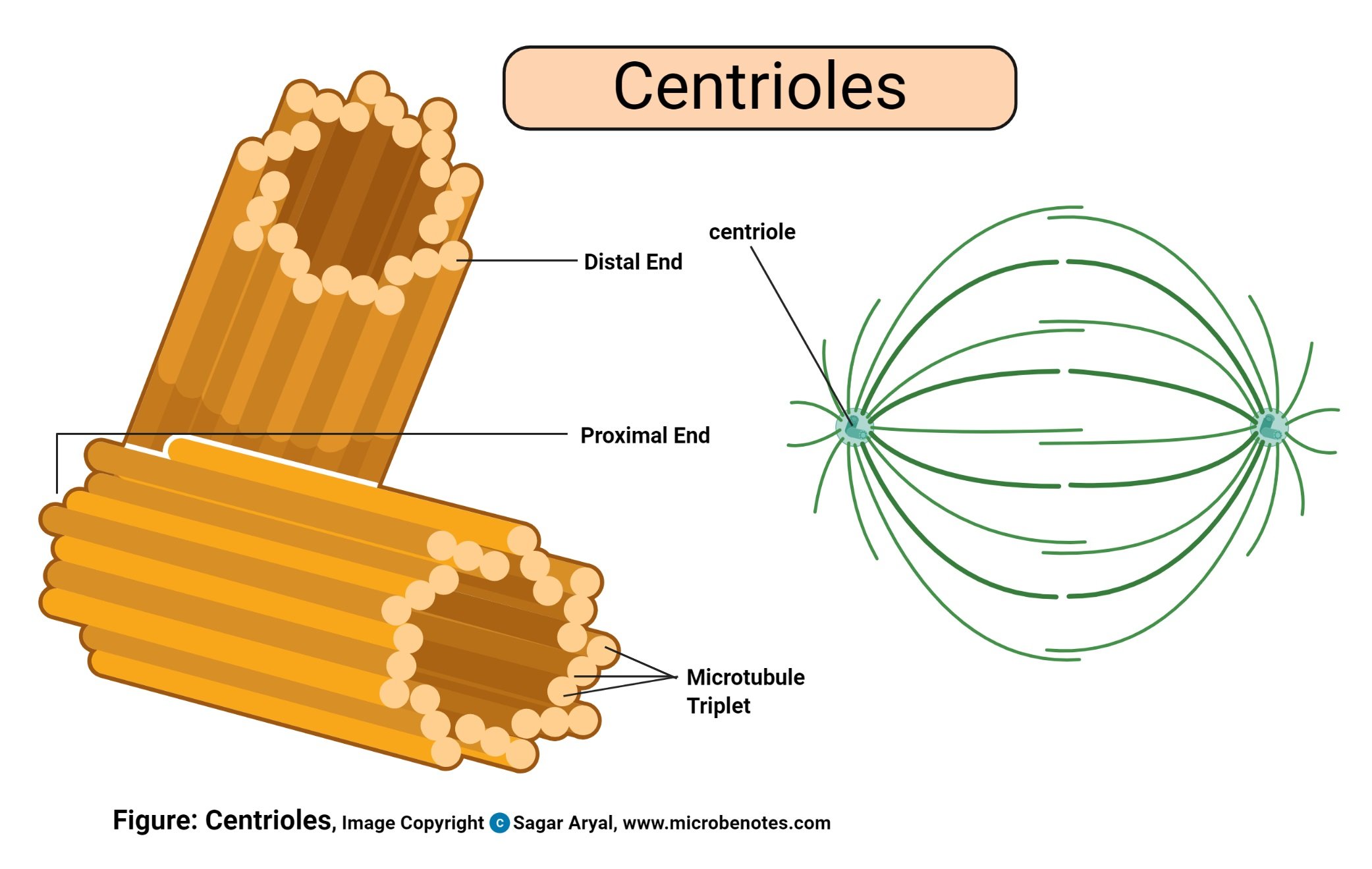
Figure: Diagram of Centrioles, created with biorender.com
Construction of Centrioles
- It is a small structure that is made up of 9 sets of microtubules, placed in groups of three hence they are triplet microtubules.
- Every bit triplets, they remain very potent together hence they accept been observed to be in structures similar cilia and flagella.
- The triplet microtubules are held together by proteins, giving the centriole its shape.
- They are found in the centrosome, creating and property microtubules within the cell.
- The triplet microtubules are surrounded by a pericentriolar matrix containing molecules that build up the microtubules.
- Each microtubule within the triplet microtubule complex is made upwards of tubulin subunits that join together forming long hollow tubes that look like straw (microtubules).
Functions of Centrioles
- The centriole microtubules allow the transportation of substances that are linked together with a glycoprotein to any cell location. the glycoprotein linkage acts as a signaling unit to move specific proteins.
- The centrioles anchor the microtubules that extend from it and comprise the factors needed to create more than tubules.
- Mitosis is accomplished past replication of each centriole which makes duplicates of each centriole (4 centrioles). The newly formed centrioles split up into ii centrosomes, each centriole at an angle to the second centriole. The microtubules between the centrosomes, push the pairs of centrioles apart, to the opposite ends of the prison cell. When the centrioles are in place, the microtubules extend to the cell cytoplasm, to seek for the chromosome. The microtubules then demark to the chromosome at the centromere. The microtubules are then unassembled fro the centriole moving the chromosomes autonomously.
Peroxisomes
These are tiny bodies found in the cytoplasm.
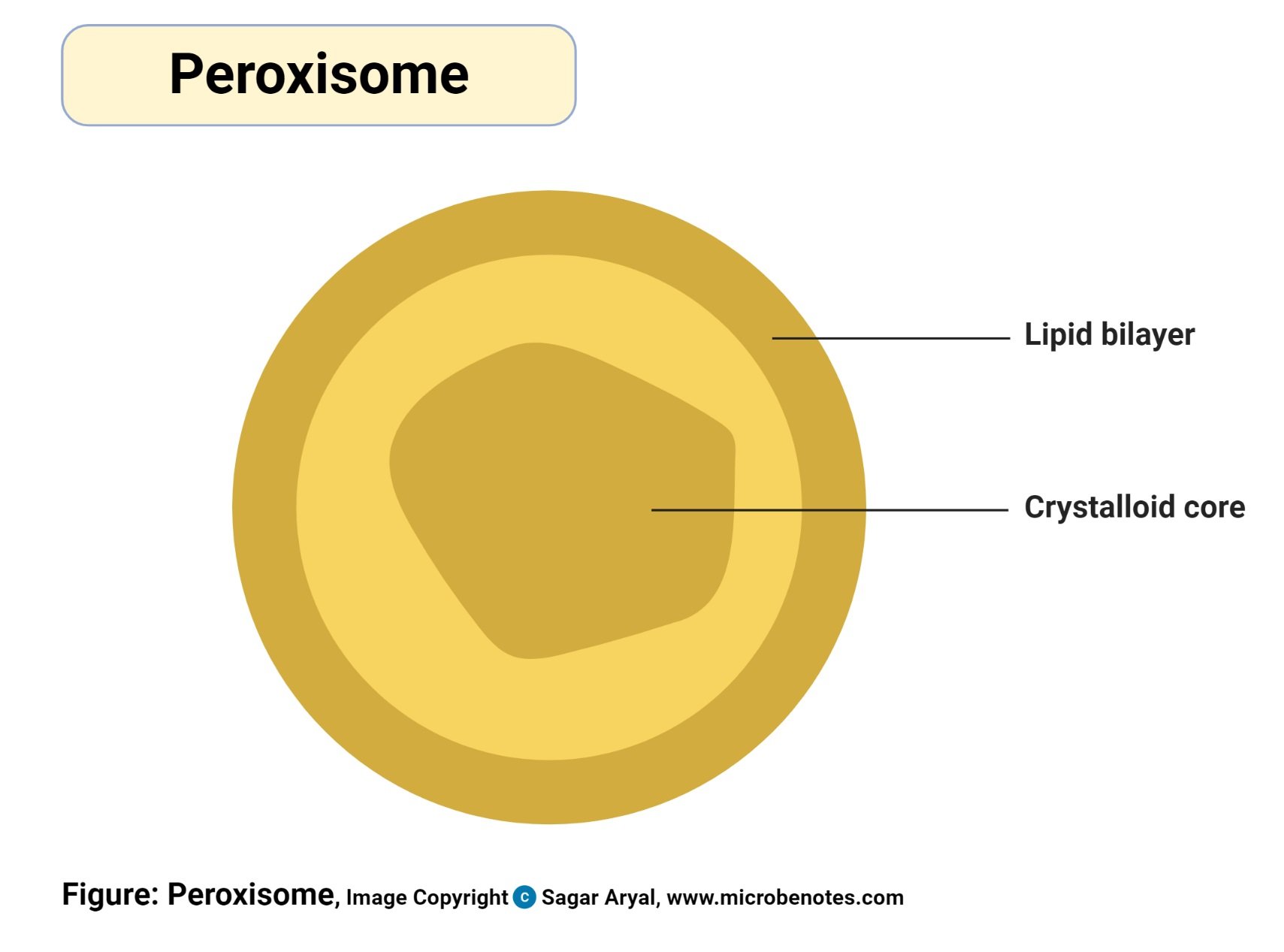
Effigy: Diagram of Peroxisome, created with biorender.com
Construction of Peroxisomes
- They are spherically shaped, bound by a membrane and they are the most common micro-bodies in the cell cytoplasm.
Functions of Peroxisomes
- Peroxisomes functions include:
- Lipid metabolism
- Chemic detoxification past moving hydrogen atoms from various oxygen molecules to produce hydrogen peroxide, hence neutralizing body poison such every bit alcohol.
- Its mechanism in Reactive Oxygen species is highly essential.
Cilia and Flagella
These are locomotive projections found on the surface of the cell.
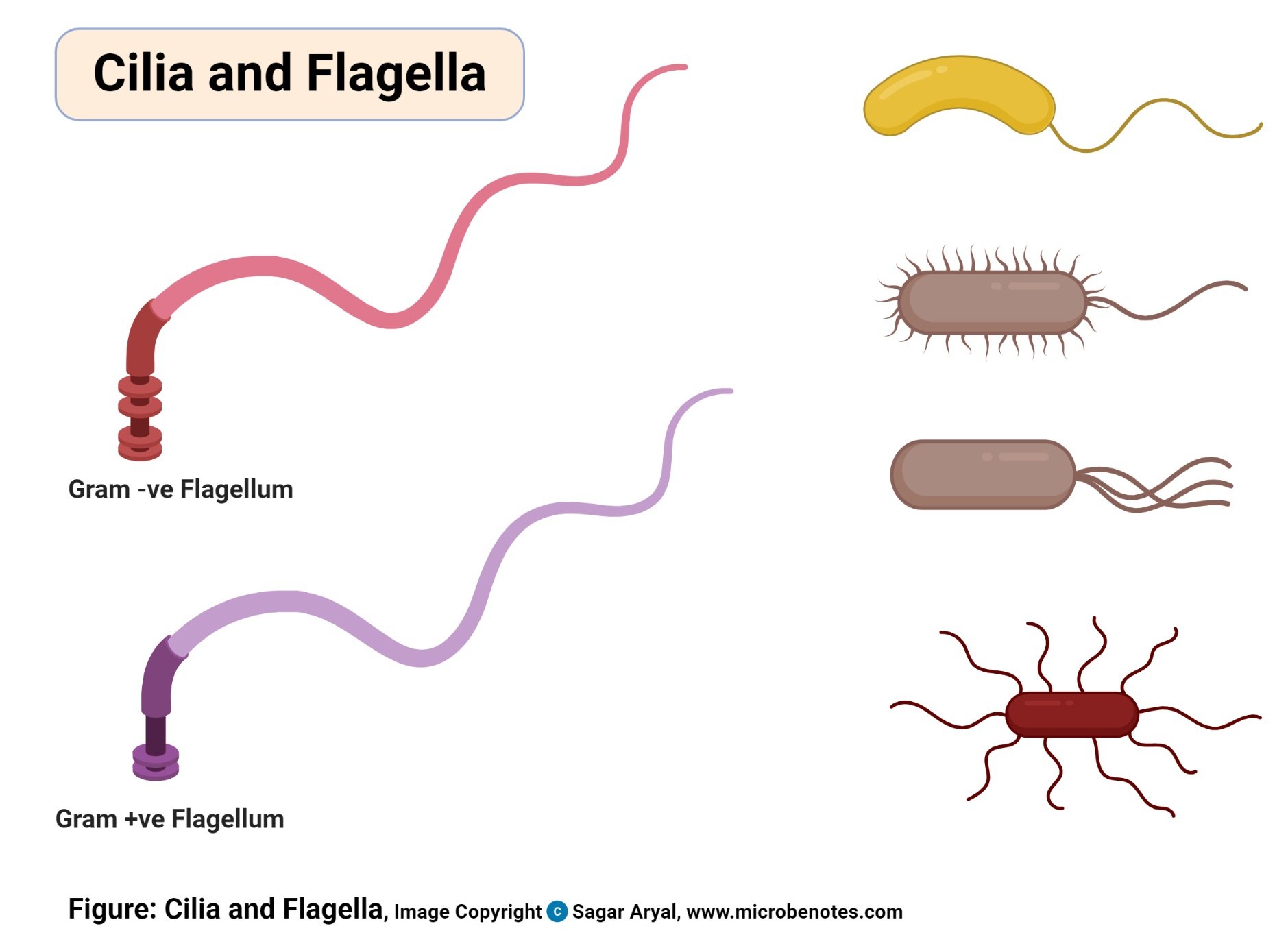
Figure: Diagram of Cilia and Flagella, created with biorender.com
Structure of Cilia and flagella
- They are made of strands of filaments. these filaments have partial and consummate microtubules that extend the projections. Fractional microtubules don't extend to the tip of the cilium and the complete microtubules extend to the tip of the cilium.
- The microtubules too have motor proteins known equally dynein making a link betwixt the fractional microtubules to the consummate microtubules.
- The whole collection is combined together as extensions on the plasma membrane of the cell.
Functions of Cilia and flagella
- Sperm cells have flagella allowing them to swim to the ova for fertilization. For single cells, such as sperm, this enables them to swim.
- Cilia in the creature cell helps move fluids away from and past immobile cells.
- Cilia assistance motility surface particles peculiarly on the epithelial lining of the nostrils and move mucus over the surface of the cell.
Endosome
These are vesicles leap by membranes and formed by a mechanism of endocytosis. They are found in the cell cytoplasm.
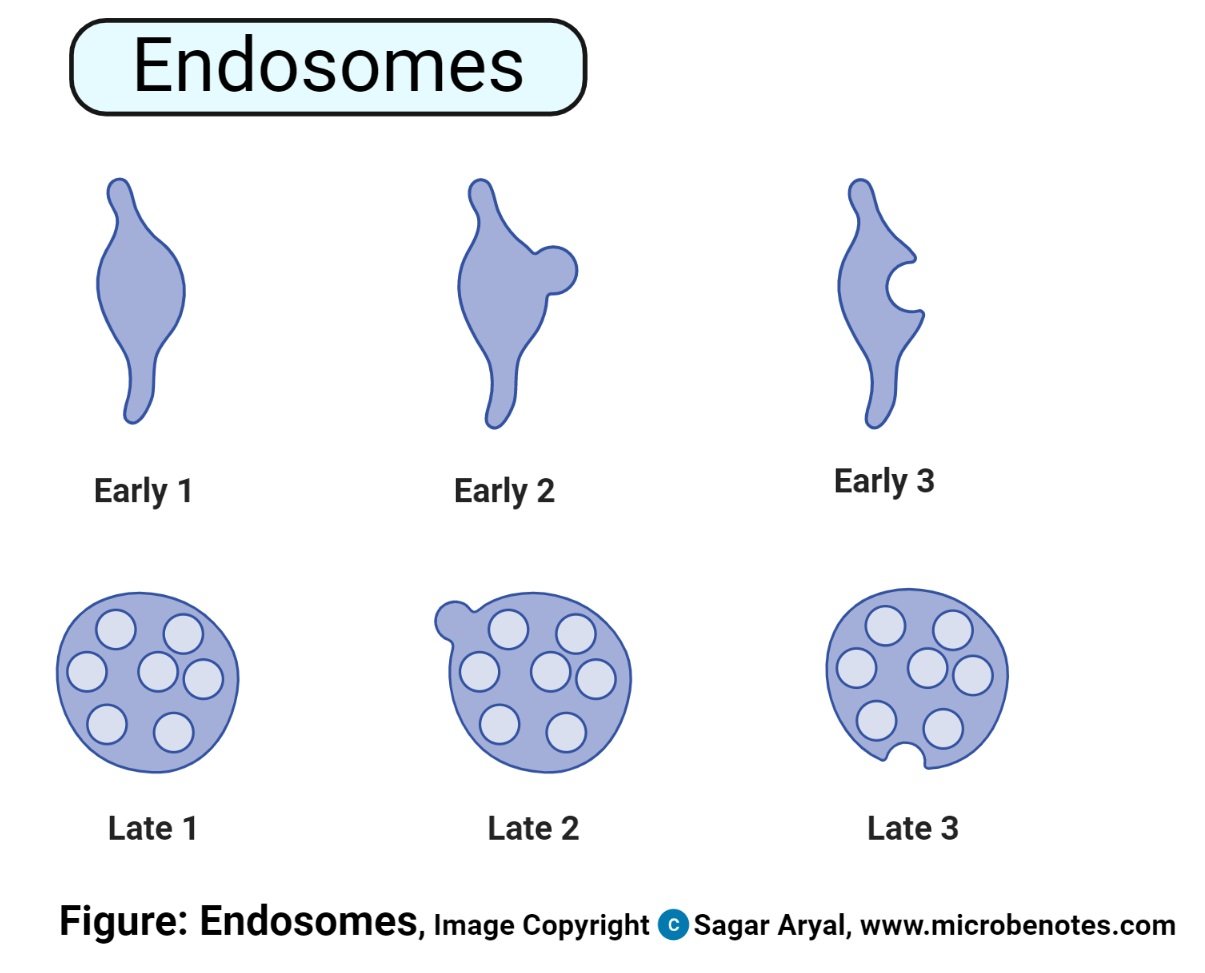
Effigy: Diagram of Endosomes, created with biorender.com
Structure of Endosome
- They are bleary organelles that are jump to the jail cell membrane.
Functions of Endosome
- Its main function involves folding in of the plasma membrane. The folding allows diffusing in of molecules through the extracellular fluids.
- Their primary function is to remove waste product materials from the cell by endocytic processes such as exocytosis and phagocytosis
Vacuoles
These are fluid-filled cell organelles enclosed by a membrane.
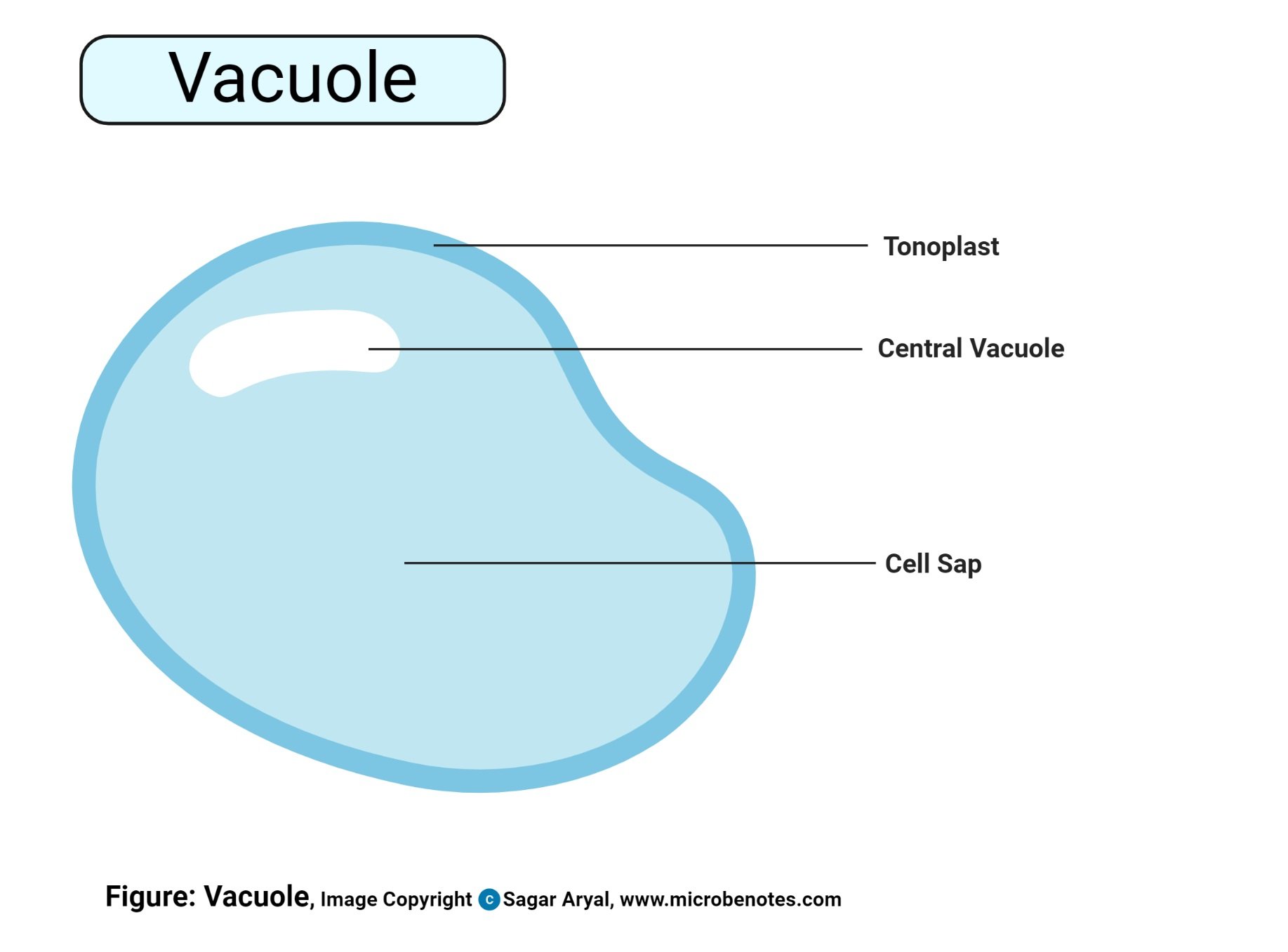
Figure: Diagram of Vacuole, created with biorender.com
Structure of Vacuoles
- They are membrane-leap sacs found within the cell cytoplasm.
- The vacuole sac has a single membrane surrounding it known as a tonoplast and this membrane resembles the plasma membrane.
Functions of Vacuoles
- their primary part is to store food, water, carbohydrates in the class of sugars and waste materials.
- Tonoplast is a regulator controlling the arrival and outflow of pocket-sized beyond a poly peptide pump
- acts as the guard for what kinds of matter are immune passage to and from vacuoles
- They likewise remove toxic substances and waste materials from the cell as a protection strategy.
- They also remove poorly folded proteins from the cell.
- Vacuoles also tin can be able to alter their functionality to provide necessary roles that suit the prison cell, by being able to change shape and size.
Microvilli
These are surface protrusions found in the intestinal lining, on egg prison cell surfaces, and on white blood cells.
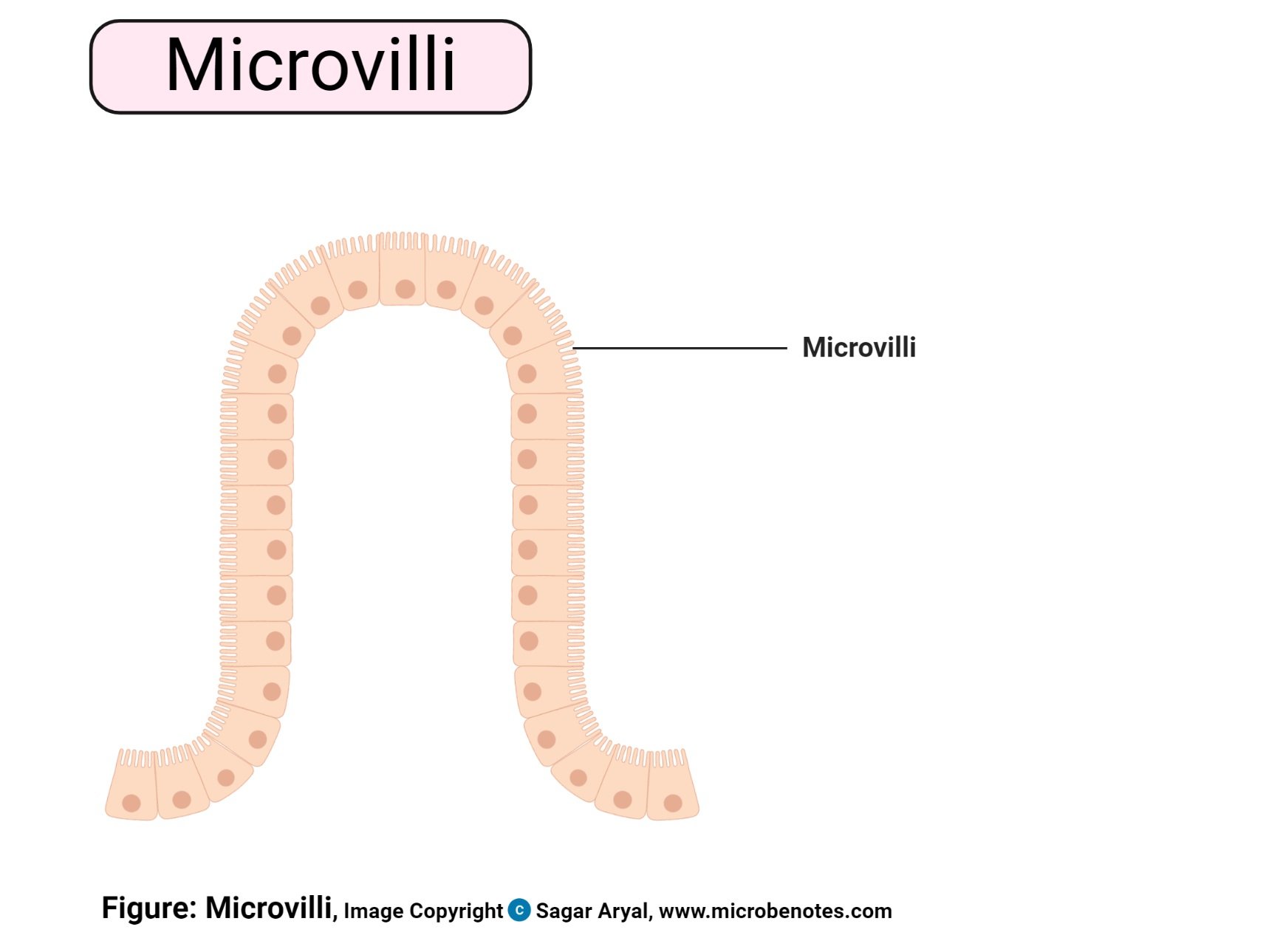
Figure: Diagram of Microvilli, created with biorender.com
Structure of Microvilli
- These are surface protrusions formed from accessory proteins of the actin filaments. The accompaniment proteins parcel together to grade microvilli on the surface of the cell membrane
Functions of Microvilli
- In the small-scale intestines, they increment the surface area for the absorption of digested food and water. Some microvilli may exist constitute in the ear for detection of sound and they transmit the audio waves to the encephalon through an electric indicate.
- They too help to anchor the sperm to the egg for easy fertilization.
- In white blood cells, they besides act as anchors allowing the white blood cells to freely move in the circulatory system to attach to possible pathogens.
References and Sources
- 1% – https://www.britannica.com/science/mitochondrion
- 1% – https://www.britannica.com/science/Golgi-apparatus
- 1% – https://hrcak.srce.hr/file/299589
- 1% – https://biologydictionary.net/centriole/
- <1% – https://www.youtube.com/watch?v=ubzw64PQPqM
- <one% – https://www.youtube.com/watch?v=MWz4ptP_QEU
- <ane% – https://world wide web.youtube.com/lookout man?v=HxdajtjxRvg
- <ane% – https://world wide web.thoughtco.com/the-cell-nucleus-373362
- <1% – https://world wide web.thoughtco.com/ribosomes-significant-373363
- <one% – https://www.thoughtco.com/dna-transcription-373398
- <1% – https://www.thoughtco.com/all-nearly-animal-cells-373379
- <one% – https://www.shmoop.com/biology-cells/plasma-membrane.html
- <ane% – https://www.sciencedirect.com/topics/neuroscience/reactive-oxygen-species
- <1% – https://www.sciencedirect.com/topics/neuroscience/cilium
- <1% – https://www.sciencedirect.com/topics/biochemistry-genetics-and-molecular-biological science/outer-mitochondrial-membrane
- <1% – https://www.quora.com/What-is-the-main-office-of-a-vacuole-in-a-institute-cell
- <1% – https://www.ncbi.nlm.nih.gov/pmc/articles/PMC3169682/
- <one% – https://www.nature.com/manufactures/352441a0
- <1% – https://www.golifescience.com/cytoskeleton/
- <i% – https://world wide web.genome.gov/genetics-glossary/Lysosome
- <one% – https://world wide web.earthslab.com/physiology/endoplasmic-reticulum/
- <1% – https://www.britannica.com/science/ribosome
- <one% – https://www.britannica.com/science/lysosome
- <ane% – https://www.britannica.com/science/cytoskeleton
- <1% – https://www.assignmentpoint.com/science/biology/virtually-lysosome.html
- <ane% – https://www.answers.com/Q/Which_part_of_the_cell_is_composed_of_microtubules_and_helps_move_chromosomes_around_during_cell_division
- <i% – https://www.answers.com/Q/Where_are_calcium_ions_stored_in_the_muscle_cell
- <1% – https://www.answers.com/Q/What_are_the_cell_organelles_that_present_only_in_eukaryotic_cell
- <1% – https://world wide web.answers.com/Q/What_are_organisms_made_of_only_one_cell_called
- <1% – https://report.com/academy/lesson/microtubules-definition-functions-structure.html
- <ane% – https://sciencing.com/two-types-endoplasmic-reticulum-8431592.html
- <i% – https://s3.amazonaws.com/scschoolfiles/631/12-2-2016_cells_vocabulary_list___definitions.pdf
- <1% – https://quizlet.com/89275056/biology-ch-vi-flash-cards/
- <i% – https://quizlet.com/72683765/cells-flash-cards/
- <1% – https://quizlet.com/69658683/cells-of-nervous-system-flash-cards/
- <1% – https://quizlet.com/6888669/jail cell-organelles-flash-cards/
- <1% – https://quizlet.com/55382975/biol380-quiz-4-prep-flash-cards/
- <i% – https://quizlet.com/49817904/prison cell-bio-1-wink-cards/
- <1% – https://quizlet.com/46072103/nutrition-chapter-three-flash-cards/
- <1% – https://quizlet.com/44872957/chapter-fourteen-genetics-flash-cards/
- <1% – https://quizlet.com/33098973/bio-cell-vocab-flash-cards/
- <1% – https://quizlet.com/2170816/ocr-gce-biological science-equally-flash-cards/
- <1% – https://quizlet.com/188524822/ch-6-bacterial-growth-nutrition-and-differentiation-wink-cards/
- <one% – https://quizlet.com/177529878/bio-examination-four-flash-cards/
- <ane% – https://quizlet.com/144988079/cytoskeleton-and-cell-motility-flash-cards/
- <1% – https://quizlet.com/11540101/characteristics-of-life-wink-cards/
- <1% – https://quizlet.com/113339181/bio-jail cell-membrane-flash-cards/
- <1% – https://quizlet.com/11324905/cell-and-organelles-flash-cards/
- <1% – https://quizlet.com/101245749/plasma-membrane-cell-membrane-flash-cards/
- <1% – https://pdb101.rcsb.org/motm/10
- <one% – https://micro.magnet.fsu.edu/cells/plants/vacuole.html
- <1% – https://in.answers.yahoo.com/question/index?qid=20070225082506AA8X0Zo
- <1% – https://ghr.nlm.nih.gov/primer/basics/cistron
- <i% – https://ghr.nlm.nih.gov/primer/basics/cell
- <i% – https://fqresearch.org/pdf_files/Reactive-Oxygen-Species-and-Aging.pdf
- <ane% – https://en.m.wikipedia.org/wiki/Inner_mitochondrial_membrane
- <1% – https://courses.lumenlearning.com/boundless-biology/chapter/the-cytoskeleton/
- <1% – https://courses.lumenlearning.com/boundless-biology/chapter/majority-ship/
- <ane% – https://byjus.com/biology/animal-cell/
- <1% – https://bscb.org/learning-resources/softcell-e-learning/ribosome/
- <1% – https://brainly.com/question/5430031
- <ane% – https://brainly.com/question/2779157
- <1% – https://biologywise.com/plant-cell-organelles
- <ane% – https://biologywise.com/cell-membrane-structure-function
- <1% – https://biologydictionary.cyberspace/polish-endoplasmic-reticulum/
- <1% – https://alevelbiology.co.uk/notes/organelle-structure-part/
- <1% – https://academic.oup.com/biomedgerontology/article/56/xi/B475/591131
- <i% – http://world wide web.cytochemistry.net/cell-biology/cilia.htm
- <1% – http://www.biologyreference.com/Co-Dn/Cytoskeleton.html
- <1% – http://new-prove.prisoner of war/10175215158/142/rough-endoplasmic-reticulum.html
Source: https://microbenotes.com/animal-cell-definition-structure-parts-functions-and-diagram/
Posted by: scottovion1999.blogspot.com

0 Response to "What Is The Structure Of A Animal Cell"
Post a Comment